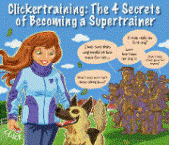Good Dog Training Advice
Get Fast & Simple Dog Training Tips to
Turn a Difficult Dog Into an Obedient Pet!
First Aid For Dogs
Dogs are carefree and very curious animals. They take interest in new things and are likely to get injured at some point in time. Puppies especially, have trouble written all over their faces. Their curiosity is likely to get the better of them as they explore new places and try to get acquainted with what looks foreign to them. For this reason, it is important to know how to offer first aid as you contact your vet for help. First aid will help reduce the dog’s suffering and prevent worsening of injuries should there be any emergencies. The list of problems you have to be prepared for is endless but most of the cases will
First aid for dogs will vary depending on the case: 1. Cuts and bruises These may result from splints of wood, barbed wire or other sharp objects the dog may encounter. Clean cuts using soap and warm water. Wash the area with soap and water to remove dirt hen apply a disinfectant over it. Disinfecting solutions include iodine and methylated spirit. Disinfecting solutions especially methylated spirit is very irritating to the skin and you should ensure that the dog is muzzled when applying. This will avoid any accidental bites out of fear. 2. Poisons These are many and may include insecticides, poisonous plants and animals such as toads. Signs of poisoning vary based on the toxin but include vomiting, diarrhoea, shock, tremors and muscle spasms. If you suspect poisoning the following steps may be followed to reduce further damage o Enhance elimination of the poison, this is done through induction of vomiting or giving laxatives that will aid in purging the contents of the gut o Reduce absorption of the poison, this may be through use of adsorbents such as activated charcoal o Give antidote, if the cause of poisoning is known and a known antidote is available this should be administered immediately. E.g. In case of warfarin poisoning, Vitamin K is given as an antidote. 3. Bites Dog’s fights are a common occurrence. In mating season, most males are likely to fight over a female on heat. In case of a dog fight, NEVER attempt to separate the dogs using your hands. If you are near a source of water, get a bucket of water and throw it on the dogs. For more details on how to prevent dog aggression towards other dogs, check this article out. Dog bites should be washed with soap and water then flushed with hydrogen peroxide. Once you take your dog to the vet, the extent of the wound can be established. 4. Heatstroke This is likely to occur of a dog is left in a poorly ventilated area with high temperature e,g in a car with closed window. The dog will have very high temperature and his breathing will be fast and shallow. Wrap the dog in a cold blanket or use towels wrapped with ice. Apply these towels on the dog especially on the muzzle and neck area. 5. Shock This is a complete failure of the cardiovascular system. It will be characterized by weak pulse, pale gums, hypothermia, and shallow respiration. If a dog is in shock remember the four basics i.e. ABCD A: Ensure that the airways are open B: If there is any bleeding stop it by applying pressure on the area C: Enhance circulation by giving fluid to maintain the blood volume D: Use drugs (This part may be left to the vet since some drugs may have adverse effects on the dog). The dog may be kept warm by wrapping with a blanket or using hot water bottles placed to the side of the dog or under. 6. Fractures A dog with a fracture will be in pain. The dog is likely to act aggressively if you attempt to touch the fractured bone. Ensure movement of the dog is limited and support the injured limb if the dog has to be moved. This support can be in form of a cushion or simply your hand. If the bone has torn through the skin, then cover the place with a clean cloth. Remember, first aid is not treatment. It only serves the purpose of offering immediate help in care of injury. Your dog must be taken to the vet for further assessment and then appropriate treatment can given.
Click here to access Doggy Dan's dog training course here... | |
|


Discover the Secrets to Training Your Dog Or Puppy. Huge BONUSES for a limited time only!
Click here now...
|
http://GoodDogTrainingAdvice.com







